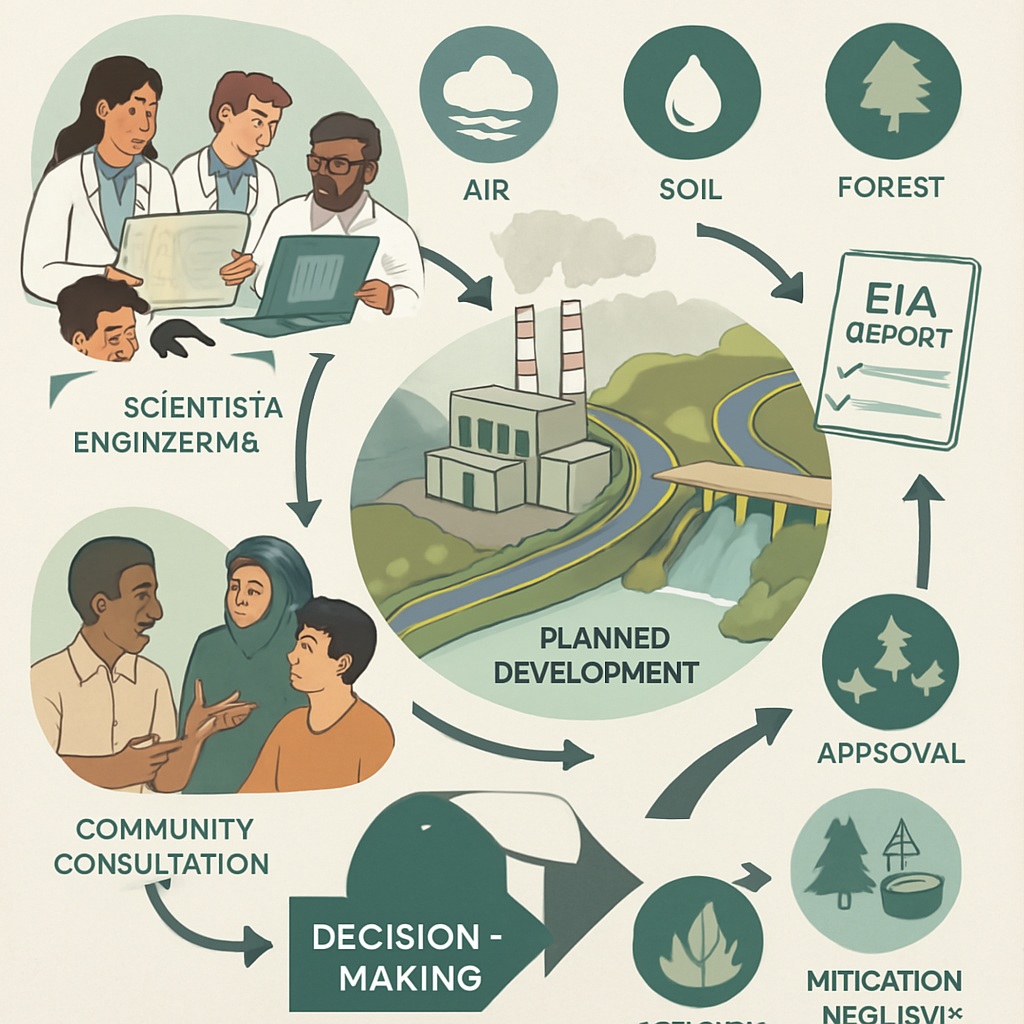Environmental Impact Assessment (EIA) is a formal process used to predict the environmental consequences of a proposed development project or policy. It aims to ensure that potential environmental effects are identified before decisions are made and actions are taken. The purpose is to promote sustainable development by integrating environmental considerations into decision-making.

Table of Contents
Detailed Principles of EIA
Precautionary Principle
Even in the absence of complete scientific certainty, if a project has the potential to cause serious or irreversible damage to the environment, preventive measures must be taken.
Example: Banning harmful chemicals suspected of causing groundwater contamination, even if conclusive proof is pending.
Prevention over Cure
The EIA process emphasizes preventing damage rather than restoring it after it has occurred, which is usually more expensive and less effective.
Comprehensive Environmental Study
An EIA must consider all possible impacts, including:
- Air and water pollution
- Soil erosion
- Biodiversity loss
- Social displacement
- Cultural and heritage impact
Public Participation and Stakeholder Involvement
The local population and concerned stakeholders must be informed and consulted, especially in projects that affect land use, water sources, forests, or tribal areas.
Example: Public hearings in India are part of the EIA process for Category A projects.
Assessment of Alternatives
Evaluation of multiple options (including “no project” option) to identify the one with the least environmental cost.
Example: Choosing a dam site that submerges less forest and displaces fewer people.
Transparency and Accessibility
EIA reports, findings, and approvals should be made available in the public domain to ensure accountability and avoid conflict of interest.
Monitoring, Compliance, and Review
After project clearance, regular environmental monitoring must be conducted to ensure adherence to conditions laid out in the EIA report.
Environmental Management
Definition and Purpose
Environmental management refers to a set of planning, control, and monitoring practices that aim to ensure the responsible use of natural resources, reduce pollution, and safeguard the environment. It is a broader concept than EIA, focusing not only on assessment but also on implementation, restoration, and long-term sustainability.
Detailed Principles of Environmental Management
-
Sustainable Development
- The goal is to ensure that development meets present needs without compromising the ability of future generations to meet their own needs.
- In practice: Use of renewable energy, water harvesting, and eco-friendly transport systems.
-
Carrying Capacity-Based Planning
- Activities and land-use planning should not exceed the natural capacity of an ecosystem to absorb impacts.
- Example: Regulating tourism in fragile ecosystems like the Himalayas or Western Ghats.
-
Polluter Pays Principle
- The entity responsible for pollution should bear the cost of cleanup and restoration.
- This principle is embedded in India’s National Environmental Policy and upheld by the National Green Tribunal (NGT).
-
Use of Best Available Technology (BAT)
- Adoption of eco-efficient technologies that minimize waste, emissions, and resource use.
- Example: Cleaner coal technologies, effluent treatment plants, solar energy systems.
-
Integrated Development Planning
- Environmental concerns must be embedded into every stage of planning—from policy formulation to project design and execution.
- Example: Environmental clearances required for mining, thermal power plants, and large real estate projects.
-
Environmental Education and Awareness
- Building awareness among citizens, especially youth, on environmental issues is essential for fostering long-term behavioral change.
- Programs like Eco-Clubs in Indian schools aim to achieve this.
-
Equity and Social Justice
- Environmental management should ensure fair distribution of resources and impacts.
- It must protect vulnerable groups such as tribal communities, slum dwellers, and women.
-
Adaptive and Participatory Management
- As environmental conditions evolve, policies should be adaptive and based on feedback.
- Involving local communities helps improve the success of conservation and mitigation programs.
Institutional Framework
- EIA Notification (2006) under the Environment (Protection) Act, 1986 guides how EIAs are to be conducted in India.
- Projects are categorized into:
- Category A (national-level, high-impact projects) – evaluated by the central government.
- Category B (lower impact) – evaluated by state authorities.
- Ministry of Environment, Forest and Climate Change (MoEFCC): Central authority for environmental policies.
- National Green Tribunal (NGT): A quasi-judicial body for addressing environmental grievances and ensuring compliance.
- State Pollution Control Boards (SPCBs): Monitor air, water, and soil pollution and grant clearances at the state level.
Conclusion
Both EIA and environmental management are essential for protecting India’s environment while promoting economic development. These frameworks help minimize ecological degradation, safeguard health, and ensure that development is equitable and sustainable. With India’s diverse ecosystems and socio-economic challenges, applying these principles thoughtfully is crucial for a balanced and resilient future.
Read: Geography Notes